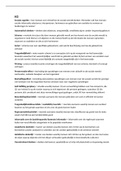Samenvatting
Summary An Introduction to Criminological Theory, ISBN: 9781138700215 Advanced Criminology (RGBUSTR011)
- Vak
- Instelling
- Boek
Complete summary about Advanced Criminology (RGBUSTR011) course book: An introduction to criminological theory ISBN: 0215 total word count: 25713 (of which summary of main points: 5000+-) Advice: skip through, focus on main points, lines of theory, models and lists next to the content of the lect...
[Meer zien]














